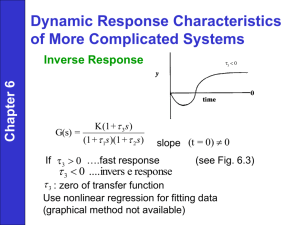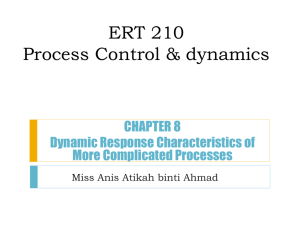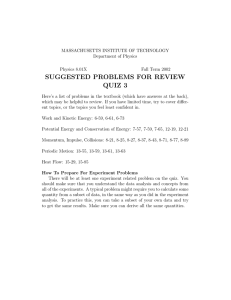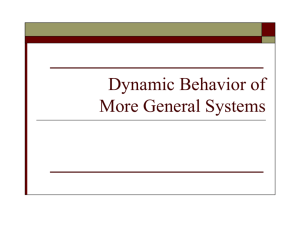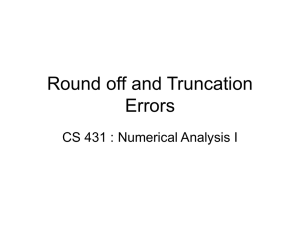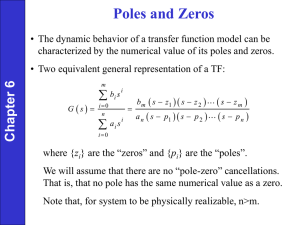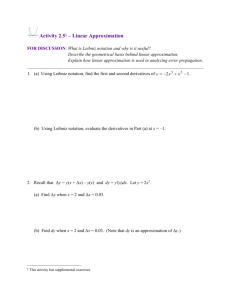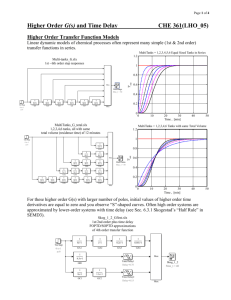ch6
advertisement
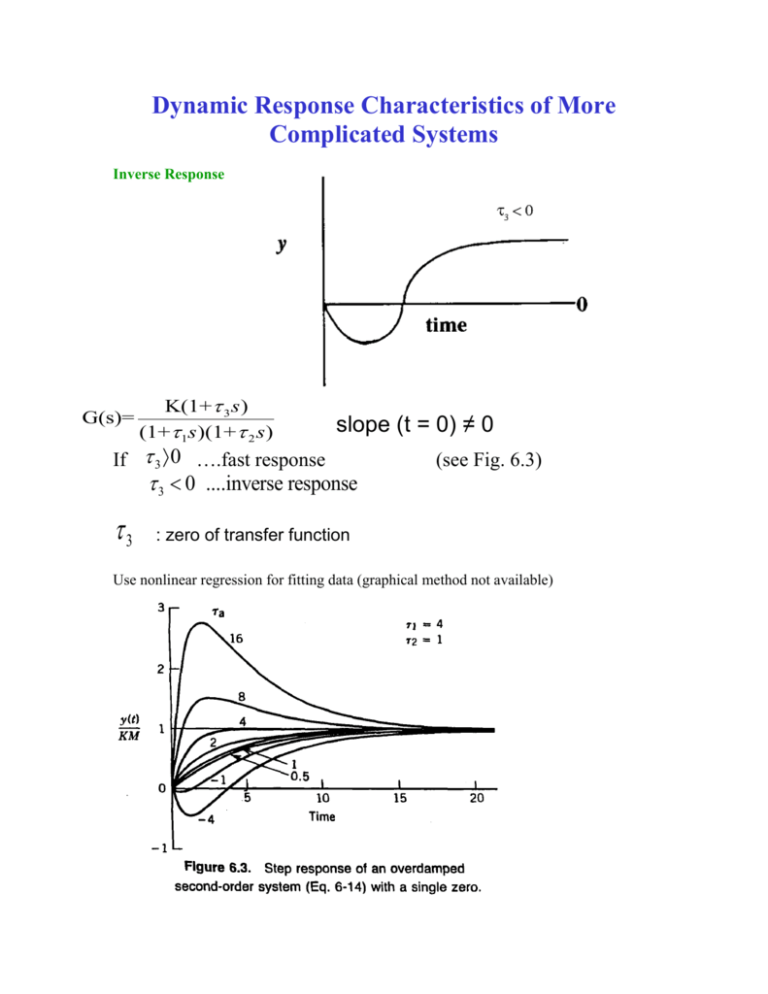
Dynamic Response Characteristics of More
Complicated Systems
Inverse Response
G(s)=
K(1+ 3 s )
(1+ 1s )(1+ 2 s )
slope (t = 0) ≠ 0
If 3 0 ….fast response
3 0 ....inverse response
3
(see Fig. 6.3)
: zero of transfer function
Use nonlinear regression for fitting data (graphical method not available)
For inverse response
G ( s)
K1 2 K 2 1
0
K1 K 2
K
s ( 1s 1)( 2 s 2 2 s 1)
4 poles (denominator is 4th order polynomial)
(6 21)
More General Transfer Function Models
•
•
Poles and Zeros:
The dynamic behavior of a transfer function model can be characterized by the
numerical value of its poles and zeros.
• General Representation of a TF:
There are two equivalent representations:
m
G s
bi si
i 0
n
(4-40)
ai si
i 0
G s
s zm
an s p1 s p2 s pn
bm s z1 s z2
(6-7)
where {zi} are the “zeros” and {pi} are the “poles”.
•
We will assume that there are no “pole-zero” cancellations. That is, that no pole
has the same numerical value as a zero.
•
Review: n m in order to have a physically realizable system.
Time Delays
Time delays occur due to:
•
Fluid flow in a pipe
•
Transport of solid material (e.g., conveyor belt)
•
Chemical analysis
-
Sampling line delay
Time required to do the analysis (e.g., on-line gas chromatograph)
Mathematical description:
A time delay, θ, between an input u and an output y results in the following
expression:
0
y t
u t θ
for t θ
for t θ
(6-27)
G ( s) e s
Y (s)
U (s)
H1/Qi has numerator dynamics (see 6-72)
Approximation of Higher-Order Transfer Functions
In this section, we present a general approach for approximating high-order transfer
function models with lower-order models that have similar dynamic and steady-state
characteristics.
In Eq. 6-4 we showed that the transfer function for a time delay can be expressed as a
Taylor series expansion. For small values of s,
e θ 0 s 1 θ 0 s
•
(6-57)
An alternative first-order approximation consists of the transfer function,
e θ 0 s
1
eθ 0 s
1
1 θ0 s
(6-58)
where the time constant has a value of
• These expressions can be used to approximate the pole or zero term in a transfer
function.
Skogestad’s “half rule”
•
•
Skogestad (2002) has proposed an approximation method for higher-order models
that contain multiple time constants.
He approximates the largest neglected time constant in the following manner.
One half of its value is added to the existing time delay (if any) and the
other half is added to the smallest retained time constant.
Time constants that are smaller than the “largest neglected time constant”
are approximated as time delays using (6-58).
Example 6.4
Consider a transfer function:
G s
K 0.1s 1
5s 1 3s 1 0.5s 1
(6-59)
Derive an approximate first-order-plus-time-delay model,
G s
Keθs
τs 1
(6-60)
using two methods:
(a) The Taylor series expansions of Eqs. 6-57 and 6-58.
(b) Skogestad’s half rule
Compare the normalized responses of G(s) and the approximate models for a unit step
input.
Solution
•
The dominant time constant (5) is retained. Applying the approximations in
(6-57) and (6-58) gives:
0.1s 1 e0.1s
(6-61)
and
1
e3s
3s 1
1
e0.5 s
0.5s 1
(6-62)
Substitution into (6-59) gives the Taylor series approximation,
GTS s :
Ke 0.1s e 3s e 0.5 s Ke 3.6 s
GTS s
5s 1
5s 1
(6-63)
(b) To use Skogestad’s method, we note that the largest neglected time constant in
(6-59) has a value of three.
•
According to his “half rule”, half of this value is added to the next largest time
constant to generate a new time constant
τ 5 0.5(3) 6.5.
•
•
•
•
The other half provides a new time delay of 0.5(3) = 1.5.
The approximation of the RHP zero in (6-61) provides an additional time delay of
0.1.
Approximating the smallest time constant of 0.5 in (6-59) by (6-58) produces an
additional time delay of 0.5.
Thus the total time delay in (6-60) is,
θ 1.5 0.1 0.5 2.1
and G(s) can be approximated as:
GSk s
Ke 2.1s
6.5s 1
(6-64)
The normalized step responses for G(s) and the two approximate models are shown in
Fig. 6.10. Skogestad’s method provides better agreement with the actual response.
Figure 6.10 Comparison of
the actual and approximate
models for Example 6.4.
Multivariable Processes
many examples:
distillation columns,
FCC,
boilers,
etc.
Consider stirred tank with level controller
2 disturbances (Ti, wi)
2 control valves (A, B) manipulate ws, wo
2 measurements (T0, h)
controlled variables (T0, h)
change in w0 affects T0 and h
change in ws only affects T0
Three non-zero transfer functions
G11
T0 ( s )
Ws ( s )
G21
H (s)
Ws ( s )
G12
T0 ( s )
W0 ( s )
G22
H (s)
W0 ( s )
Transfer Function Matrix
T0 ( s) G11 G12 Ws ( s)
H ( s ) G
21 G22 W0 ( s)
From material and energy balances,
G11
K11
1s 1
G22
K 22
2s 1
G12
K12
( 1s 1)( 2 s 1)
Normal method, but interactions may present tuning problems.
In multivariable control, interactions are treated, but controller design is more
complicated.
